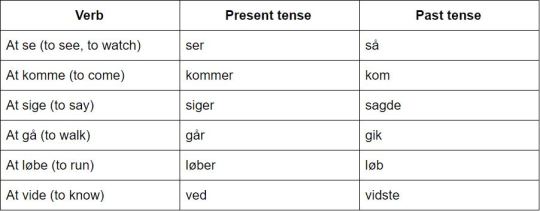#irregular verbs
Check out this lesson at danishwithemi.com
In Danish we can differentiate between three different types of verbs: regular verbs (type 1), regular verbs (type 2) and irregular verbs. In this lesson we will look at the irregular verbs and how it conjugates in present and past tense. Remember that the conjugation of a verb is the same across all pronouns. If you missed the lesson on regular verbs of type 1 and 2 then click here: regular verbs 1,regular verbs 2
Some verbs does not follow the same rules as the regular verbs. Therefore, irregular verbs needs to be memorized. Don’t worry if you can’t remember these verbs for now! With practice and constant exposure to the Danish language (e.g. through reading) it should come eventually.
Irregular verbs

Most irregular verbs in present tense is conjugated the same way as regular verbs (with an “r” added at the end of the verb). However, this is not always the case (see the verb “at vide” in the table above), so be aware.
Example sentences
Jeg ser en film = I am watching a movie
De så fem episoder = They watched five episodes
Hvornår kommer du? = When are you coming? / When do you come?
Han siger ikke noget = He doesn’t say anything
Hvad sagde hun? = What did she say?
Jeg går en tur = I am going for a walk
De gik en tur om morgenen = They went for a walk in the morning
Hun løber tre gange om ugen = She runs three times a week
Du løb væk = You ran away
Ved du hvad klokken er? = Do you know what the time is?
Jeg ved det ikke = I don’t know
Jeg vidste det! = I knew it!
If you have any questions or feedback feel free to submit a question/feedback at danishwithemi.tumblr.com/ask and I will answer as soon as possible.
the verb (to) be in German
Ich bin
Du bist
Er/sie/es ist
Wir sind
Ihr seid
Sie sind
